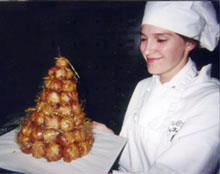Pastry
Pastry is a dough of flour, water and shortening (solid fats, including butter) that may be savoury or sweetened. Sweetened pastries are often described as bakers' confectionery. The word "pastries" suggests many kinds of baked products made from ingredients such as flour, sugar, milk, butter, shortening, baking powder, and eggs. Small tarts and other sweet baked products are called pastries. Common pastry dishes include pies, tarts, quiches, and pasties.
Types of Pastry[edit | edit source]
The main types of pastry are:
- Shortcrust pastry: The simplest and most common pastry. It is made with flour, fat, and water to bind the dough. This is used for tarts, pies, and quiches.
- Puff pastry: Made with several layers of fat which are folded into the dough to create a flaky, light pastry after baking. It is used for pastries like croissants, Danish pastries, and vol-au-vents.
- Choux pastry: A light pastry dough used to make éclairs, cream puffs, and profiteroles. It employs high moisture content to create steam during cooking to puff the pastry.
- Filo pastry: A very thin unleavened dough used for making pastries like baklava and börek in Middle Eastern and Balkan cuisines.
- Hot water crust pastry: A type of pastry used for savory pies, such as pork pies, game pies, and, more rarely, steak and kidney pies. Hot water crust is traditionally used for making hand-raised pies.
Ingredients[edit | edit source]
The primary ingredients in pastry making include:
- Flour: The basic structure of the pastry. Wheat flour is the most common type used.
- Fats: Including butter, lard, or vegetable shortening. Fats are incorporated into the dough to give the pastry its texture.
- Liquids: Water, milk, or eggs are used to bind the dough and affect the tenderness and flakiness of the finished product.
- Sugar: Added for sweetness and to tenderize the pastry.
- Leavening agents: Such as baking powder or yeast, may be used in some pastries to produce a lighter, airier texture.
Preparation and Techniques[edit | edit source]
Pastry making involves various techniques that affect the texture and flavor of the finished product. These include:
- Rubbing in: A method where fat is rubbed into the flour before adding any liquid to make breadcrumbs-like texture.
- Folding: Used in making puff pastry, where the dough is repeatedly folded and rolled to create layers.
- Blind baking: Pre-baking the pastry crust before adding the filling to prevent it from becoming soggy.
- Glazing: Applying egg or milk wash before baking to give the pastry a golden and glossy finish.
Cultural Significance[edit | edit source]
Pastry has a significant place in various cultures around the world, with each having its unique variations and specialties. For example, in France, pastries like croissants and éclairs are an integral part of the cuisine. In the Middle East, pastries such as baklava are traditionally served during festive occasions.
See Also[edit | edit source]
Transform your life with W8MD's budget GLP1 injections from $125
W8MD offers a medical weight loss program NYC and a clinic to lose weight in Philadelphia. Our W8MD's physician supervised medical weight loss centers in NYC provides expert medical guidance, and offers telemedicine options for convenience.
Why choose W8MD?
- Comprehensive care with FDA-approved weight loss medications including:
- loss injections in NYC both generic and brand names:
- weight loss medications including Phentermine, Qsymia, Diethylpropion etc.
- Accept most insurances for visits or discounted self pay cost.
- Generic weight loss injections starting from just $125.00 for the starting dose
- In person weight loss NYC and telemedicine medical weight loss options in New York city available
- Budget GLP1 weight loss injections in NYC starting from $125.00 biweekly with insurance!
Book Your Appointment
Start your NYC weight loss journey today at our NYC medical weight loss, and Philadelphia medical weight loss Call (718)946-5500 for NY and 215 676 2334 for PA
Search WikiMD
Ad.Tired of being Overweight? Try W8MD's NYC physician weight loss.
Semaglutide (Ozempic / Wegovy and Tirzepatide (Mounjaro / Zepbound) available. Call 718 946 5500.
Advertise on WikiMD
|
WikiMD's Wellness Encyclopedia |
| Let Food Be Thy Medicine Medicine Thy Food - Hippocrates |
Translate this page: - East Asian
中文,
日本,
한국어,
South Asian
हिन्दी,
தமிழ்,
తెలుగు,
Urdu,
ಕನ್ನಡ,
Southeast Asian
Indonesian,
Vietnamese,
Thai,
မြန်မာဘာသာ,
বাংলা
European
español,
Deutsch,
français,
Greek,
português do Brasil,
polski,
română,
русский,
Nederlands,
norsk,
svenska,
suomi,
Italian
Middle Eastern & African
عربى,
Turkish,
Persian,
Hebrew,
Afrikaans,
isiZulu,
Kiswahili,
Other
Bulgarian,
Hungarian,
Czech,
Swedish,
മലയാളം,
मराठी,
ਪੰਜਾਬੀ,
ગુજરાતી,
Portuguese,
Ukrainian
Medical Disclaimer: WikiMD is not a substitute for professional medical advice. The information on WikiMD is provided as an information resource only, may be incorrect, outdated or misleading, and is not to be used or relied on for any diagnostic or treatment purposes. Please consult your health care provider before making any healthcare decisions or for guidance about a specific medical condition. WikiMD expressly disclaims responsibility, and shall have no liability, for any damages, loss, injury, or liability whatsoever suffered as a result of your reliance on the information contained in this site. By visiting this site you agree to the foregoing terms and conditions, which may from time to time be changed or supplemented by WikiMD. If you do not agree to the foregoing terms and conditions, you should not enter or use this site. See full disclaimer.
Credits:Most images are courtesy of Wikimedia commons, and templates, categories Wikipedia, licensed under CC BY SA or similar.
Contributors: Prab R. Tumpati, MD




















